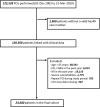Practice patterns and trends in the use of medical therapy in patients undergoing percutaneous coronary intervention in Ontario
- PMID: 25122664
- PMCID: PMC4310369
- DOI: 10.1161/JAHA.114.000882
Practice patterns and trends in the use of medical therapy in patients undergoing percutaneous coronary intervention in Ontario
Abstract
Background: Clinical guidelines emphasize medical therapy as the initial approach to the management of patients with stable coronary artery disease (CAD). However, the extent to which medical therapy is applied before and after percutaneous coronary intervention (PCI) in contemporary clinical practice is uncertain. We evaluated medication use for patients with stable CAD undergoing PCI, and assessed whether the COURAGE study altered medication use in the Canadian healthcare system.
Methods and results: A population-based cohort of 23 680 older patients >65 years old) with stable CAD undergoing PCI in Ontario between 2003 and 2010 was assembled. Optimal medical therapy (OMT) was defined as prescription for a β-blocker, statin, and either angiotensin-converting enzyme inhibitor or angiotensin II receptor blocker in the 90 days before PCI, and the same medications plus thienopyridine 90 days following PCI. Prior to PCI, 8023 (33.9%) patients were receiving OMT, 11 891 (50.2%) were on suboptimal therapy, and 3766 (15.9%) were not prescribed any medications of interest. There was significant improvement in medical therapy following PCI (OMT: 11 149 [47.1%], suboptimal therapy: 11 591 [48.9%], and none: 940 [4.0%], P<0.001). Utilization rate of OMT reduced significantly after the publication of COURAGE (34.9% before versus 32.8% after, P<0.001). Similarly, the rate of OMT following PCI was lower in the period after publication of COURAGE (47.3% before versus 46.9% after, P<0.001).
Conclusions: OMT was prescribed in about 1 in 3 patients prior to PCI and less than half after PCI. In contrast to the anticipated impact of COURAGE, we found lower rates of medication use in PCI patients after its publication.
Keywords: optimal medical therapy; outcomes; percutaneous coronary intervention; stable coronary artery disease.
© 2014 The Authors. Published on behalf of the American Heart Association, Inc., by Wiley Blackwell.
Figures
References
-
- Ford ES, Ajani UA, Croft JB, Critchley JA, Labarthe DR, Kottke TE, Giles WH, Capewell S. Explaining the decrease in U.S. deaths from coronary disease, 1980‐2000. N Engl J Med. 2007; 356:2388-2398. - PubMed
-
- Wijeysundera HC, Machado M, Farahati F, Wang X, Witteman W, van der Velde G, Tu JV, Lee DS, Goodman SG, Petrella R, O'Flaherty M, Krahn M, Capewell S. Association of temporal trends in risk factors and treatment uptake with coronary heart disease mortality, 1994‐2005. JAMA. 2010; 303:1841-1847. - PubMed
-
- Boden WE, O'Rourke RA, Teo KK, Hartigan PM, Maron DJ, Kostuk WJ, Knudtson M, Dada M, Casperson P, Harris CL, Chaitman BR, Shaw L, Gosselin G, Nawaz S, Title LM, Gau G, Blaustein AS, Booth DC, Bates ER, Spertus JA, Berman DS, Mancini GB, Weintraub WS. Optimal medical therapy with or without PCI for stable coronary disease. N Engl J Med. 2007; 356:1503-1516. - PubMed
-
- Teo KK, Sedlis SP, Boden WE, O'Rourke RA, Maron DJ, Hartigan PM, Dada M, Gupta V, Spertus JA, Kostuk WJ, Berman DS, Shaw LJ, Chaitman BR, Mancini GB, Weintraub WS. Optimal medical therapy with or without percutaneous coronary intervention in older patients with stable coronary disease: a pre‐specified subset analysis of the COURAGE (clinical outcomes utilizing revascularization and aggressive drug evaluation) trial. J Am Coll Cardiol. 2009; 54:1303-1308. - PubMed
-
- Dagenais GR, Lu J, Faxon DP, Kent K, Lago RM, Lezama C, Hueb W, Weiss M, Slater J, Frye RL. Effects of optimal medical treatment with or without coronary revascularization on angina and subsequent revascularizations in patients with type 2 diabetes mellitus and stable ischemic heart disease. Circulation. 2011; 123:1492-1500. - PubMed
Publication types
MeSH terms
Substances
LinkOut - more resources
Full Text Sources
Other Literature Sources
Medical
Miscellaneous


